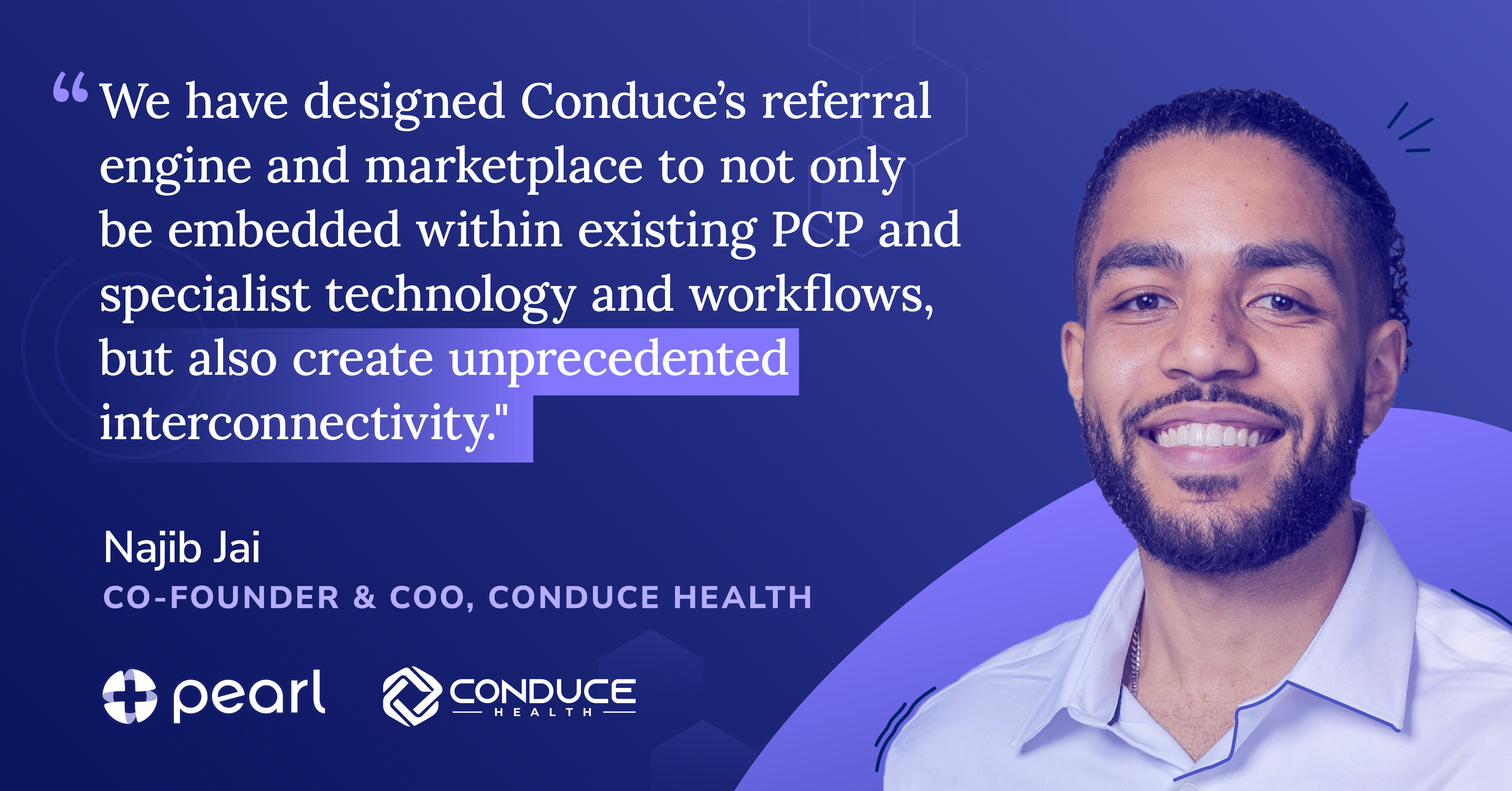Over nearly two decades, true, total-cost-of-care value-based care (VBC) has been defined through the lens of primary care providers (PCPs) — the quarterbacks of patient care — and what they can do to improve outcomes through proactive and responsive panel management. In support of these physicians, VBC enablement companies like Pearl have stepped in to help PCPs transition to value with the right software, tooling, financial underwriting, and operational assistance needed for success.
As these models mature, policies change, and margins compress, ongoing success in VBC will require an increasing emphasis on high-cost and complex patient care, with a discrete focus on specialists.
This next chapter in the value-based care story presents an array of challenges: hyper-local dynamics impacting primary and specialty care relationships, complex patient attribution models, and the nuances inherent to different specialties (and corresponding patient needs) introduce the need for a novel competency within the VBC ecosystem. While many specialty-specific solutions in nephrology, orthopedics, cardiology, and oncology have been introduced, Conduce Health, founded in 2023, is building an infrastructural layer to support inclusion and integration of specialists and multi-specialty models into the existing VBC landscape.
Through the approach of Conduce’s marketplace and two product offerings — Clinical Profiles and the Referral Engine — Conduce Health and Pearl Health have launched a unique partnership in South Carolina to tackle the needs of complex, polychronic patients and the network of physicians managing their care. Below is a conversation between Pearl Health’s Chief Operating Officer, Gabriel Drapos, and Conduce Health’s Co-Founder and Chief Operating Officer, Najib Jai, about what this partnership will mean for providers and their patients.
Najib Jai: What challenges does this partnership help you solve?
Gabriel Drapos: Having a partner identify, contract and manage a key set of specialists in a given market allows Pearl to scale while keeping its strategy and focus on the large undertaking of shifting PCP workflows toward VBC outcomes. At the same time, we will increasingly need to support PCPs through wrap-around services and local, value-aligned specialists that are incentivized to ensure closed-loop referrals and proactive management of those aspects of patient care outside the proper scope of primary care.
Najib Jai: What makes specialty care management challenging as a primary care enablement platform?
Gabriel Drapos: Part of it is contracting — for every primary care practice that joins Pearl, there are likely 5–10 critical specialty and ancillary providers whose inclusion would enhance Pearl’s ability to improve outcomes. While we do some of that highest-priority work in-house, it’s not practicable to scale that nationwide. Finding the appropriate balance of “build or partner” is important for any successful startup.
The other aspects of specialty care management that can be challenging are:
- Changing PCP referral patterns to specialists that demonstrate better outcomes, and
- Managing the ongoing visibility of patient care between two providers who are unlikely to be in a shared EHR (unless they are already part of a Clinically Integrated Network).
The first challenge can be solved by showing not only the reasons a given specialist may be preferable to the PCP’s incumbent referral patterns, but also being able to defend the specialist’s financial alignment to these patients achieving desirable outcomes. The second challenge will require partners like Conduce to help improve co-management of patients.
Najib Jai: How do you think about changing provider behavior at Pearl?
Gabriel Drapos: First, we believe that, by changing cash flows and incentives, we can arm an under-equipped primary care landscape with the funds needed to resource proactive, targeted patient engagement.
Second, we need to surface the signals most impactful to a patient’s improved outcomes in an intuitive, easy-to-engage with way, which is why experience design (alongside thoughtful user research and testing) is such a focus of our technology work at Pearl.
Third, you need to maintain trust, so when Pearl suggests a patient needs evaluation or engagement, our physician partners trust those suggestions. We always roll out a new signal starting with the very highest confidence patients (e.g. those most likely to present to the ED in the next two weeks), and only expand stepwise once we have built that trust, and until we achieve a pareto optimal point of appropriate patient interventions vs false positives.
Fourth, workflows need to reduce practice work over time, rather than add to it — which is why we are always looking to increase automation for administrative (not clinical) tasks. This can include things like scheduling a patient visit when it’s warranted, rather than asking the practice to reach out and schedule; and texting patients once they’re discharged from the hospital to schedule a post-discharge check-in, so practices only need to reach out to those that don’t engage with the Pearl-driven outreach.
Gabriel Drapos: What are Conduce Clinical Profiles and what is the use case?
Najib Jai: Fundamentally our initial thesis around specialist performance was that the paradigm of “good doctor, bad doctor” was an antiquated misconception that could be materially improved through data science and technology. Our solution is predicated on what we call Conduce Clinical Profiles, which is our proprietary methodology to cohort patients by incorporating a combination of their chronic conditions (e.g., CKD 4 or 5), comorbidities, and social determinants of health information (i.e., income within a given zip code).
We leverage these clinical profiles to evaluate specialists within existing primary care provider referral patterns. The results consistently illustrate heterogenous performance for a single specialist across profiles. Intuitively it makes sense that subtle variables associated with where a specialist trained or the frequency with which they’ve treated certain conditions would result in certain strengths and weaknesses impacting clinical performance. Our clinical profiles unearth these informative nuances. It’s less a matter of the binary “good doctor versus bad doctor” and, more accurately, a matter of “good doctor for whom.”
Gabriel Drapos: How do you think about building specialist networks?
Najib Jai: One of the more consonant pain points we hear from at-risk primary care organizations is the challenge of contracting with local or vendor-based specialists and consistently operationalizing these relationships successfully. Questions related to who to contract with, under what value-based arrangements, and for which patient populations continue to perplex the industry. We believe this isn’t a result of inability, but more so a reflection of a competency outside the scope of enabling value-based primary or specialist care (and all of the important work that requires). For this reason, we have positioned Conduce to serve as that contracting entity on behalf of many at-risk primary care groups and specialty platforms to operationalize the insights of our Clinical Profiles.
Gabriel Drapos: How do you see Conduce fitting in with existing workflows and technology platforms?
Najib Jai: We’ve always recognized that providing information on specialist performance through the perspective of Conduce Clinical Profiles was necessary, but insufficient in closing the gap to true value-based specialty care, which is why we built the Conduce Referral Engine. This productizes the insights of which specialists are best positioned to provide the highest quality of care for a given patient. Having spent my career in many clinical environments and working at Oak Street Health, I have both seen and palpably experienced the mutual challenges of introducing novel workflows and the opacities associated with patients existing across multiple clinical settings. For this reason we have designed Conduce’s referral engine and marketplace to not only be embedded within existing PCP and specialist technology and workflows, but also create unprecedented interconnectivity. Pearl Health’s technological sophistication and Signal-Action Framework make them an excellent partner in ensuring the right information is surfaced to providers.
Gabriel Drapos: How do you think about the nuances most applicable to specific specialties?
Najib Jai: Our aim at Conduce is to bridge the gap between primary and specialty care, not directly provide it clinically. This intermediary positioning allows us to focus more on what is consistent across specialties versus the important differences. Each of our Clinical Profiles are contained within specialty-specific categories, but the process and implementation of the Referral Engine is consistent across specialties.
Gabriel Drapos: What would success look like to you in this partnership and where do you hope to see it go from here?
Najib Jai: We’re incredibly excited to support Pearl’s enablement of primary care providers in South Carolina. Having gone through the process of creating Conduce Clinical Profiles and subsequently identifying and contracting more than 150 high-performance specialists for Pearl’s patient population, we’re looking forward to the launch and implementation of our Referral Engine this month. With an initial focus on nephrology, we anticipate many learnings and initial results centered on PCP uptake of our referral optimization recommendations, patients receiving the best specialist care for their respective needs, and closing a variety of historical information gaps between primary and specialty care.



